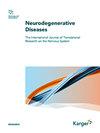血浆半胱氨酸蛋白酶抑制剂C与血浆NfL水平相关并预测帕金森病的疾病进展
IF 1.9
4区 医学
Q3 CLINICAL NEUROLOGY
引用次数: 3
摘要
引言:先前的研究报道了帕金森病(PD)患者血浆胱抑素C(Cys-C)水平的升高,并声称这可能与疾病的严重程度和进展有关。本研究的目的是评估PD和健康对照组(HC)的血浆Cys-C,并在一项纵向研究中测试其与外周炎症、神经退行性变和临床进展标志物的相关性。方法:在基线时评估71例连续非痴呆PD和69例HC患者的血浆Cys-C、高敏C反应蛋白、白细胞介素6和神经丝轻链(NfL)。PD患者在基线和2年随访后接受了广泛的运动和认知评估。Cys-C与疾病严重程度的相关性在多线性模型中进行了评估,该模型根据年龄、性别、疾病持续时间和外周炎症的影响进行了调整。结果:与对照组相比,帕金森病患者的Cys-C水平似乎更高,并与血浆神经元标志物NfL相关(r=0.204,p=0.046)。在纵向分析中,Cys-C含量较高的帕金森病患者在随访2年时表现出更快的运动进展,与外周炎症无关。结论:Cys-C与帕金森病患者较高的NfL水平和显著更快的运动进展有关,与外周炎症无关。需要进一步的研究来了解Cys-C与神经退行性疾病中更高的神经元损伤标志物相关的机制。本文章由计算机程序翻译,如有差异,请以英文原文为准。
Plasma Cystatin C Correlates with Plasma NfL Levels and Predicts Disease Progression in Parkinson’s Disease
Introduction: Previous studies reported increased plasma levels of cystatin C (Cys-C) in Parkinson’s disease (PD) and claimed for a possible association with disease severity and progression. The aim of this study was to evaluate plasma Cys-C in PD and healthy controls (HC) and test its association with markers of peripheral inflammation, neurodegeneration, and clinical progression in a longitudinal study. Methods: Plasma Cys-C, high-sensitive C-reactive protein, interleukin 6, and neurofilament light chain (NfL) were assessed at the baseline in 71 consecutive non-demented PD and 69 HC. PD patients underwent an extensive motor and cognitive assessment at baseline and after 2 years of follow-up. The association of Cys-C with disease severity was evaluated in a multilinear model adjusted for the effect of age, sex, disease duration, and peripheral inflammation. Results: Cys-C levels appeared to be higher in PD compared to controls and correlated with the plasma neuronal marker NfL (r = 0.204, p = 0.046). In longitudinal analyses, PD patients with higher Cys-C levels exhibited faster motor progression at 2 years of follow-up independently from the peripheral inflammatory profile. Conclusions: Cys-C was associated with higher NfL levels and a remarkably faster motor progression in PD independently from peripheral inflammation. Further studies are needed in order to understand the mechanisms underpinning the association of Cys-C with higher neuronal damage markers in neurodegenerative diseases.
求助全文
通过发布文献求助,成功后即可免费获取论文全文。
去求助
来源期刊

Neurodegenerative Diseases
医学-临床神经学
CiteScore
5.90
自引率
0.00%
发文量
14
审稿时长
6-12 weeks
期刊介绍:
''Neurodegenerative Diseases'' is a bimonthly, multidisciplinary journal for the publication of advances in the understanding of neurodegenerative diseases, including Alzheimer''s disease, Parkinson''s disease, amyotrophic lateral sclerosis, Huntington''s disease and related neurological and psychiatric disorders.
 求助内容:
求助内容: 应助结果提醒方式:
应助结果提醒方式:


